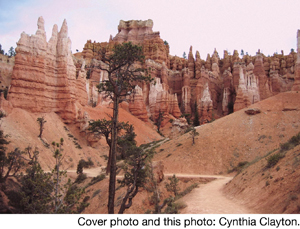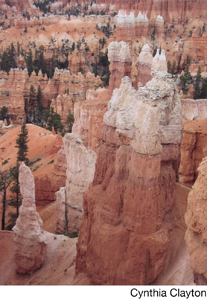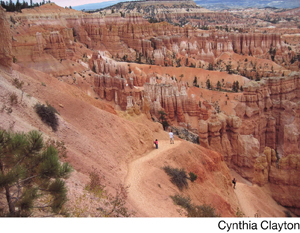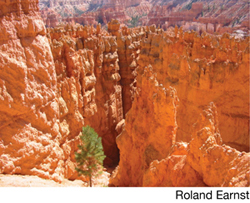
 It seems to be universally
agreed, that faith in God
and in the Bible is under heavy attack in today’s world. Atheist Web
sites dominate much of the Web and are increasingly aggressive in their
outreach to young people. Much of the information on these sites is
false. The falsehood comes not only from the misunderstandings that
atheists have of Christianity and the Bible, but also because they can
find ample material produced by believers that can easily be shown to
be incorrect. The primary purpose of this journal is education. For 42
years we have been producing factual material on science, faith, and
the Bible that comes from people who are schooled in these areas. That
does not mean we never misunderstand or make a mistake, but if we do,
we try to correct it. Religious people and atheists alike misread
messages — both the messages in the Bible and the messages in God’s
creation — the natural world that surrounds us.
It seems to be universally
agreed, that faith in God
and in the Bible is under heavy attack in today’s world. Atheist Web
sites dominate much of the Web and are increasingly aggressive in their
outreach to young people. Much of the information on these sites is
false. The falsehood comes not only from the misunderstandings that
atheists have of Christianity and the Bible, but also because they can
find ample material produced by believers that can easily be shown to
be incorrect. The primary purpose of this journal is education. For 42
years we have been producing factual material on science, faith, and
the Bible that comes from people who are schooled in these areas. That
does not mean we never misunderstand or make a mistake, but if we do,
we try to correct it. Religious people and atheists alike misread
messages — both the messages in the Bible and the messages in God’s
creation — the natural world that surrounds us.
The cover of this issue of our journal and the
pictures on these pages show one of the areas that we visit in our
“Canyonlands Seminar.” (Click this link
for information on this year’s
seminar.) Bryce Canyon in Utah is not only a beautiful place to see,
but there are many things in the area that are related to questions
about the fossil record and the age of the earth. The spires you see in
the  pictures are called
hoodoos. They
are places where a hard cap rock
has protected the softer layers below from erosion creating these
interesting spires. This is a common feature of eroded areas that have
layers of hard rock above softer rock, and can be seen in many places
in the world, but nowhere more clearly than in Bryce Canyon.
pictures are called
hoodoos. They
are places where a hard cap rock
has protected the softer layers below from erosion creating these
interesting spires. This is a common feature of eroded areas that have
layers of hard rock above softer rock, and can be seen in many places
in the world, but nowhere more clearly than in Bryce Canyon.
One of the things that can be seen in creationist
literature and museums is what creationists call “polystrate fossils.”
The term poly means many, and strate refers to layers or strata of
rock. Sometimes trees will be seen cutting up through many layers of
rock. The trees are vertical, and the claim is that the rock layers
could not have been laid down over a long period of time. The argument
is that the tree could not have existed over the long periods of time
the geologists claim were required for the rock layers to be deposited.
Some creationists have even suggested that the rock layers had to be
flood deposits burying the trees instantly or the formation with the
trees cutting through it could not exist.
The picture on the cover shows an interesting place
on the main trail going through the hoodoos in Bryce Canyon National
Park. There are less known areas of the park where similar trees grow
in a place where the canyon walls touch the tree. If sediment were to
be deposited in this area, the tree and all of the rock layers would be
preserved. Then if it were later exposed after many years it would be
called a polystrate fossil.
 The point here is that creationists are misreading
the message. There are many clues that should help avoid such an error.
The rocks deposited around a tree growing up through rock layers should
tell you what took place. Flood layers are always clastic rocks — rocks
deposited by running water like shale (mud), sandstone (sand),
conglomerate (gravel), or breccia (landslide gravel). Limestone,
dolomite, gypsum, halite, and geodes are chemically precipitated
rocks — rocks crystalized out of quiet pools of water and never
produced by a flood. Basalt, rhyolite, scoria, pumice, andesite, and
porphyries are volcanic rocks and are also not produced by a flood.
Every polystrate fossil I have seen was surrounded by rocks that were
not flood deposits. When creationists make this kind of claim they are
misreading the message of the rocks. The problem is that any young
person who has had a course in earth science has studied petrology (the
study of rocks), and knows that most claims about polystrate fossils
are not true. This can produce a faith crisis in a thinking young
person who wants to know what is true and sees the Church as
misinformed.
The point here is that creationists are misreading
the message. There are many clues that should help avoid such an error.
The rocks deposited around a tree growing up through rock layers should
tell you what took place. Flood layers are always clastic rocks — rocks
deposited by running water like shale (mud), sandstone (sand),
conglomerate (gravel), or breccia (landslide gravel). Limestone,
dolomite, gypsum, halite, and geodes are chemically precipitated
rocks — rocks crystalized out of quiet pools of water and never
produced by a flood. Basalt, rhyolite, scoria, pumice, andesite, and
porphyries are volcanic rocks and are also not produced by a flood.
Every polystrate fossil I have seen was surrounded by rocks that were
not flood deposits. When creationists make this kind of claim they are
misreading the message of the rocks. The problem is that any young
person who has had a course in earth science has studied petrology (the
study of rocks), and knows that most claims about polystrate fossils
are not true. This can produce a faith crisis in a thinking young
person who wants to know what is true and sees the Church as
misinformed.
Another example of misreading the message is the
subject of uniformitarianism. This belief is the cornerstone of
evolution and much of geology. What it says is that the only processes
that have ever happened on the earth are the processes going on today.
When scientists study rock layers they assume that erosion, volcanoes,
weathering, glaciers, earthquakes, sedimentation, etc., are what
produced the layers because that is what is producing the layers today.
To be facetious, if an alien brought a dump truck space ship to the
earth and dumped a bunch of their garbage, uniformitarianism methods
would fail to be able to explain it. This is avoided by assuming no
such thing has ever taken place. In the case of alien dump trucks, this
is probably a good assumption. The fact is, however, that we now know
that comets and asteroids have struck the earth in the past, and the
effects they would have on the earth are debated because that process
is not happening today.
Many times you will see creationists and atheists
alike talking about catastrophes that have affected the earth. The
claim is made that uniformitarianism is disproved by evidence of
massive volcanoes erupting in the American Northwest, or by tsunamis.
These events may be catastrophes to humans, but they do not violate
uniformitarianism, because we see them happening today and we know what
the results of such things are. We are misreading the message when we
talk about a catastrophe that affects the earth and assume it poses
some problems for evolutionists and/or geologists.
Similar problems take place in misreading the Bible.
One claim of almost all atheists from Richard Dawkins to most of the
atheist Web sites is that God is an unpleasant person. Richard Dawkins
wrote in his book, The God Delusion,
that
God
is
“arguably
the
most
unpleasant character in all of fiction: jealous and proud of it; a
petty, unjust, unforgiving, control freak; a vindictive, bloodthirsty
ethnic cleanser; a misogynistic, homophobic, racist, infanticidal,
genocidal, filicidal, pestilential, megalomaniacal, sadomasochistic,
capriciously malevolent bully.”
The point here is that Dawkins and his followers
misread the message. God is not a human with human weakness and
failings! So why is God referred to in the male gender in the Bible
(Him, He, Father, etc.)? There is no neuter in the Hebrew language, so
if a gender identity were to be given to God of any kind it would have
to be done contextually. For that reason when war, power, strength,
punishment, and provision are being emphasized a male identity is
given. Throughout scriptures however, there are female attributes and
identities given to God when themes like love, compassion, nurturing,
etc., are present. Consider Matthew 23:37 (NIV) “O Jerusalem,
Jerusalem, you who kill the prophets and stone those sent to you, how
often I have longed to gather your  children together, as a hen gathers
her chicks under her wings, but you were not willing.” Even the most
severe critics of the Bible have to admit this is not a male image.
When people attribute gender inequities to the Bible they are
misreading the message.
children together, as a hen gathers
her chicks under her wings, but you were not willing.” Even the most
severe critics of the Bible have to admit this is not a male image.
When people attribute gender inequities to the Bible they are
misreading the message.
Many of the misunderstandings of the Genesis account
are also due to misreading the message, combined with a failure to take
the Bible literally — and this is true of fundamentalists and atheists
alike. When did creation occur? What does the Bible actually say? Is
the “creation week” really a creation week? We are not asking whether
the days were seven 24-hour days (they probably were), we are asking,
“What does the Bible actually say and are we misreading the creation
account because of our denominational traditions?”
In the minds of the ancient Hebrews, God functions
in two ways. He acts miraculously, but He also acts
naturally — by manipulating natural processes. Jesus was conceived
miraculously, but His birth and early childhood were accomplished
naturally. Jesus was not zapped into existence as a 29-year-old mature
male. He was born naturally and lived normally and naturally like any
other young Jewish male. Luke 2:41– 52
makes it clear that the early
life of Jesus was that of a normal child.
The creation verse of the
Genesis account is verse
1. The Hebrew word that emphasizes this is the word bara, which is only
used in Hebrew in reference to something God does — never in reference
to a natural process or to something a human does. The entire process
of creation from absolutely nothing to the matter of which we are made
and the planet on which we live is in verse 1. This includes the sun,
moon, stars, and all interstellar matter. “In the beginning” in Hebrew
is reshith and refers to the
physical earth on which we live. There are
many other Hebrew words that refer to the start of something that has a
natural source. Techillah
means “to commence.” Rosh
refers to “the
head” of something. Rishon
refers to “the former” of something. The
word reshith means “the first, the absolute start” of something. But
the word bara refers to something supernatural which only God can do.
The method God used to create time, space, and
energy is not stated in verse 1. In modern science we have quantum
mechanics with a completely new set of scientific laws that help
explain how quarks, electrons, protons, and ultimately hydrogen came
into existence. Quantum mechanics does not violate the science of the
past. It expands our understanding of how things that are a part of
other dimensions can ultimately cause the building blocks of matter to
come into existence. Contrary to what some atheists claim, quantum
mechanics does not prove that something can come from nothing. What it
tells us is that there are dimensions beyond the X, Y, and Z dimensions
we know, and that creation came from laws which govern these other
dimensions. Genesis starts with what ancient man could understand — the
physical cosmos that we observe with our senses.
The ultimate message to those who take the Bible
seriously is that God created a functional earth in verse 1. The Hebrew
word for earth here is erets,
which refers to a working, functional
earth. If a blob of guck was what God wanted us to understand He would
have used tselem, meaning an
image or shadow, or tsurah,
meaning an
outline. In verse 2 of Genesis we read
that a natural change  occurred
in the earth — it became or was “without form, and void.” The Hebrew
for “without form” is tohu,
meaning “vacant” or “ruined.” There is
compelling evidence of astronomical catastrophes early in the earth’s
history, one of which wiped out the dinosaurs. In the creation week we
see continued natural change. This change is directed by God, but the
Hebrew word used in these verses is asah,
meaning
“to
make
or
naturally
form”
— not to miraculously create. In verses
14 –19 a natural change
allows the sun, moon, and stars to be seen and used to establish “signs
to mark seasons and days and years” (verse 14). It is not until verse
21 that bara is used, and then again in verse
27. Verse 21 refers to
complex life in the sea and verse 27 refers to man’s soul. Everything
else is done by natural process if we take the Bible literally. In
chapter 2, verse 3, the distinction in
God’s methods are clearly laid
out, “he rested from all his work which God created (bara) and made
(asah)”. God did both.
occurred
in the earth — it became or was “without form, and void.” The Hebrew
for “without form” is tohu,
meaning “vacant” or “ruined.” There is
compelling evidence of astronomical catastrophes early in the earth’s
history, one of which wiped out the dinosaurs. In the creation week we
see continued natural change. This change is directed by God, but the
Hebrew word used in these verses is asah,
meaning
“to
make
or
naturally
form”
— not to miraculously create. In verses
14 –19 a natural change
allows the sun, moon, and stars to be seen and used to establish “signs
to mark seasons and days and years” (verse 14). It is not until verse
21 that bara is used, and then again in verse
27. Verse 21 refers to
complex life in the sea and verse 27 refers to man’s soul. Everything
else is done by natural process if we take the Bible literally. In
chapter 2, verse 3, the distinction in
God’s methods are clearly laid
out, “he rested from all his work which God created (bara) and made
(asah)”. God did both.
When there is a conflict between the message we read
in the natural world that we can observe — that which science
studies — and what we read in the biblical account, we know we have
either misread the natural world or we have misread the Bible. The
lesson of history is that we have misread both in the past — and we
need to work harder not to do so in the future.
Back to Contents
Does God Exist?, MarApr10.


 It seems to be universally
agreed, that faith in God
and in the Bible is under heavy attack in today’s world. Atheist Web
sites dominate much of the Web and are increasingly aggressive in their
outreach to young people. Much of the information on these sites is
false. The falsehood comes not only from the misunderstandings that
atheists have of Christianity and the Bible, but also because they can
find ample material produced by believers that can easily be shown to
be incorrect. The primary purpose of this journal is education. For 42
years we have been producing factual material on science, faith, and
the Bible that comes from people who are schooled in these areas. That
does not mean we never misunderstand or make a mistake, but if we do,
we try to correct it. Religious people and atheists alike misread
messages — both the messages in the Bible and the messages in God’s
creation — the natural world that surrounds us.
It seems to be universally
agreed, that faith in God
and in the Bible is under heavy attack in today’s world. Atheist Web
sites dominate much of the Web and are increasingly aggressive in their
outreach to young people. Much of the information on these sites is
false. The falsehood comes not only from the misunderstandings that
atheists have of Christianity and the Bible, but also because they can
find ample material produced by believers that can easily be shown to
be incorrect. The primary purpose of this journal is education. For 42
years we have been producing factual material on science, faith, and
the Bible that comes from people who are schooled in these areas. That
does not mean we never misunderstand or make a mistake, but if we do,
we try to correct it. Religious people and atheists alike misread
messages — both the messages in the Bible and the messages in God’s
creation — the natural world that surrounds us.
 pictures are called
hoodoos. They
are places where a hard cap rock
has protected the softer layers below from erosion creating these
interesting spires. This is a common feature of eroded areas that have
layers of hard rock above softer rock, and can be seen in many places
in the world, but nowhere more clearly than in Bryce Canyon.
pictures are called
hoodoos. They
are places where a hard cap rock
has protected the softer layers below from erosion creating these
interesting spires. This is a common feature of eroded areas that have
layers of hard rock above softer rock, and can be seen in many places
in the world, but nowhere more clearly than in Bryce Canyon. The point here is that creationists are misreading
the message. There are many clues that should help avoid such an error.
The rocks deposited around a tree growing up through rock layers should
tell you what took place. Flood layers are always clastic rocks — rocks
deposited by running water like shale (mud), sandstone (sand),
conglomerate (gravel), or breccia (landslide gravel). Limestone,
dolomite, gypsum, halite, and geodes are chemically precipitated
rocks — rocks crystalized out of quiet pools of water and never
produced by a flood. Basalt, rhyolite, scoria, pumice, andesite, and
porphyries are volcanic rocks and are also not produced by a flood.
Every polystrate fossil I have seen was surrounded by rocks that were
not flood deposits. When creationists make this kind of claim they are
misreading the message of the rocks. The problem is that any young
person who has had a course in earth science has studied petrology (the
study of rocks), and knows that most claims about polystrate fossils
are not true. This can produce a faith crisis in a thinking young
person who wants to know what is true and sees the Church as
misinformed.
The point here is that creationists are misreading
the message. There are many clues that should help avoid such an error.
The rocks deposited around a tree growing up through rock layers should
tell you what took place. Flood layers are always clastic rocks — rocks
deposited by running water like shale (mud), sandstone (sand),
conglomerate (gravel), or breccia (landslide gravel). Limestone,
dolomite, gypsum, halite, and geodes are chemically precipitated
rocks — rocks crystalized out of quiet pools of water and never
produced by a flood. Basalt, rhyolite, scoria, pumice, andesite, and
porphyries are volcanic rocks and are also not produced by a flood.
Every polystrate fossil I have seen was surrounded by rocks that were
not flood deposits. When creationists make this kind of claim they are
misreading the message of the rocks. The problem is that any young
person who has had a course in earth science has studied petrology (the
study of rocks), and knows that most claims about polystrate fossils
are not true. This can produce a faith crisis in a thinking young
person who wants to know what is true and sees the Church as
misinformed.
 children together, as a hen gathers
her chicks under her wings, but you were not willing.” Even the most
severe critics of the Bible have to admit this is not a male image.
When people attribute gender inequities to the Bible they are
misreading the message.
children together, as a hen gathers
her chicks under her wings, but you were not willing.” Even the most
severe critics of the Bible have to admit this is not a male image.
When people attribute gender inequities to the Bible they are
misreading the message.
 occurred
in the earth — it became or was “without form, and void.” The Hebrew
for “without form” is tohu,
meaning “vacant” or “ruined.” There is
compelling evidence of astronomical catastrophes early in the earth’s
history, one of which wiped out the dinosaurs. In the creation week we
see continued natural change. This change is directed by God, but the
Hebrew word used in these verses is asah,
meaning
“to
make
or
naturally
form”
— not to miraculously create. In verses
14 –19 a natural change
allows the sun, moon, and stars to be seen and used to establish “signs
to mark seasons and days and years” (verse 14). It is not until verse
21 that bara is used, and then again in verse
27. Verse 21 refers to
complex life in the sea and verse 27 refers to man’s soul. Everything
else is done by natural process if we take the Bible literally. In
chapter 2, verse 3, the distinction in
God’s methods are clearly laid
out, “he rested from all his work which God created (bara) and made
(asah)”. God did both.
occurred
in the earth — it became or was “without form, and void.” The Hebrew
for “without form” is tohu,
meaning “vacant” or “ruined.” There is
compelling evidence of astronomical catastrophes early in the earth’s
history, one of which wiped out the dinosaurs. In the creation week we
see continued natural change. This change is directed by God, but the
Hebrew word used in these verses is asah,
meaning
“to
make
or
naturally
form”
— not to miraculously create. In verses
14 –19 a natural change
allows the sun, moon, and stars to be seen and used to establish “signs
to mark seasons and days and years” (verse 14). It is not until verse
21 that bara is used, and then again in verse
27. Verse 21 refers to
complex life in the sea and verse 27 refers to man’s soul. Everything
else is done by natural process if we take the Bible literally. In
chapter 2, verse 3, the distinction in
God’s methods are clearly laid
out, “he rested from all his work which God created (bara) and made
(asah)”. God did both.